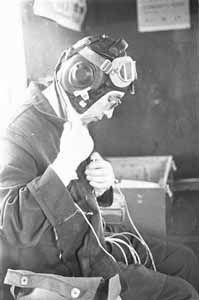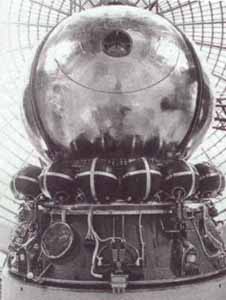|
Living being |
Spacecraft |
| Data acquisition and processing;
exchange of data with other living beings; means of data
acquisition (eyes, ears, senses of touch and smell) and data
processing (central and peripheral nervous systems) |
Acquisition and processing of data
about environment and position (angular orientation and
distance), acceleration thrust; acquisition of "new"
data with the aid of relevant means (distance-measuring, radio,
optical and gyro equipment); means for processing the data
acquired (data processing computer centers, shipborne computers
and crew) |
| Survival in environments changeable
over a wide range, normal internal conditions which provide for
reliable functioning of the organism, means of maintaining
internal stability (heat transfer through skin, blood
circulation, etc.) |
Space flight in environments
changeable over a wide range (high g loading and strong
vibration at launching and reentry, thermal reentry shock, space
vacuum, cyclic solar radiation, micrometeorite impacts, etc.);
life-support and survival system which provides for normal
functioning of crew and equipment (leak-proof compartments,
thermal insulation, control of temperature and atmosphere aboard
spacecraft) |
| Faculty to orient and move in space
owing to the organs of coordination and balance (eyes, inner ear
labyrinth) and the means of locomotion (legs, wings, etc.) |
Maneuverability for trajectory
adjustments and environmental moment control; means of position
control (optical, gyro, radio and other computerized
equipment linked to appropriate controls: mass-expulsion jets,
spinning pitch wheels, etc.) and means of momentum control
(thrusters, rocket stages, electrical propulsion engines of
space probes) |
| Food for replenishing lost energy |
Shipborne supplies of food, water,
oxygen and power to meet the needs of crew and equipment; means
of power generation and facilities for reclaiming shipborne
supplies of expendables and partly consumable stock |
| Reserve strength required in case of
emergency or recuperation from serious injury or illness;
reserve strength should never be used to support rudimentary
material needs as is often the case in games and during other
activities |
Adequate safety factor of structure,
standby systems and individual items of equipment, reserve power
in excess of the requirements that are needed to carry out
missions, regular tests of individual items of equipment and
spacecraft as a whole |
| Automatic coordination and
synchronization of all internal functions |
Coordinated control of all shipborne
systems, adjusting equipment for good functioning in changeable
conditions of space mission |
A question which involuntary arises is how will man and automaton
share the responsibility aboard a spacecraft?
According to Feoktistov every operation that can be automated on
board a spaceship should be automated. The designer treats every person
as an [additional] fraction of the payload. A man assigned to cope only
with control functions is an unjustifiable luxury. No craft is designed
to carry dead weight. It must have a payload that performs a kind of
useful work. This can be, for example, research. Therefore, steps must
be taken to render spacecraft control simple and executable without high
skills and during a minimum time. Every second of space flight is very
expensive and must be utilized with a maximum effect.
|

